A few weeks back I packed up a bunch of seedlings, strapped ’em to the back of my bike with an old rubber tube, and headed down to Surry Hills for the Artist as Family’s “Food Forest Plant-In-Day”.
As far as I understand it, the idea of a “Food Forest” is this: unlike your standard garden, it has an integrated system of layers: from large trees, to smaller trees, to an “understorey” and finally ground covers. All these elements work in tandem to support and nurture each other. The Food Forest, at its best, moves towards the state of a natural forest. In other words, it becomes stable and self-sustaining. Theoretically, it will require much less human intervention once it’s properly established.
Here’s a great drawing which I nicked from Wikipedia’s page on “forest gardening“. (I do believe Wikipedia might have nicked that picture from Bill Mollison’s Permaculture book):
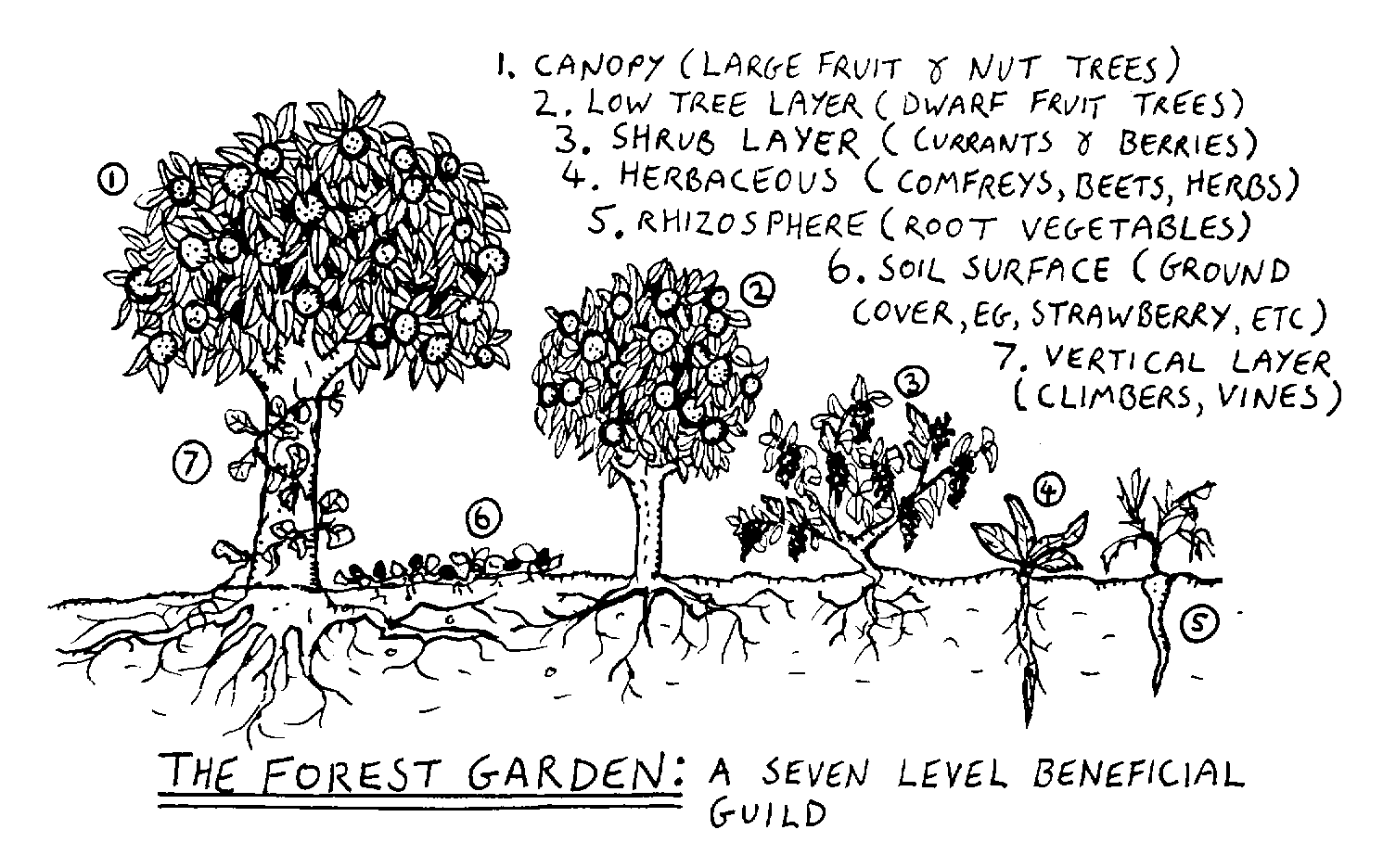
All forests, in a sense, are “food forests”. I’m thinking of my recent visit to the Daintree in Queensland, where every plant, animal, fungus and bacteria was fodder for all the others: the whole system constantly gobbling and regenerating itself.
The only difference in the case of the Artist as Family is that “food” is specifically defined as that which is edible by humans…
I’ve never visited one of these anthropocentric forests before. As an amateur gardener myself, I can well imagine the pleasure of Patrick, Meg and Zephyr as they planned and created their forest on the lawn outside St Michael’s Church on Albion street.
However, the Artist as Family lives in Victoria, so it can’t have been all that easy to establish a new garden so far away from home. This is no doubt one of the reasons they organised a plant-in day, inviting anyone who was interested to come along with something to plant.
There’s a great set of photos on their own website, here, showing some of the folks who turned up on the day.
And here below is a selection of my own shots… Many of the people who came along did not know the Artist as Family personally. They attended through their own curiosity, often due to a pre-existing fascination or interest in some aspect of urban gardening…
This is Todd, my classmate from the Permaculture course, whose business by day is “auditing strange things“. Todd is an enthusiastic gardener who lives down the south coast. He says he’s trying to change the culture in his local suburb – not by rallying or organising committees, but simply by being an example. He says, “I am trying to be the Joneses that everyone else will soon be wanting to keep up with”. At the Plant-In Day, Todd had an i-phone “app” which helped you to make companion planting decisions. This turned out to be surprisingly handy, as people kept arriving with lettuces, parsley, spinach, strawberries, and wondering where to plant them. Patrick and Meg happily handed over this advice-giving responsibility to Todd and his toy.
Here’s Lisa, my neighbour from North Petersham, who brought along a small mulberry tree which had spontaneously erupted in her garden. Lisa has a long and abiding interest in nurturing woebegon trees – last year she did a wonderful project where she hand-reared dozens of the much-maligned London Plane Trees (you see them towering over the streets all over Sydney):
Here’s Pete, who (to my knowledge) didn’t bring along anything particularly botanical, apart from the inevitable jokes about sneaking a few not-quite-legal plant specimens into the forest… Pete actually has much more knowledge of farming than I’ve ever really thought to tap into:
Here are Tessa and Karl, from the group Makeshift (also participating in the In the Balance exhibition). By now, I’ve forgotten what they brought along, but I remember it was something a little eccentric. (Makeshift are in the process of finalising their mobile beehive-honey cart, from which they’ll be serving pancakes during the exhibition on the front lawn of the MCA.)
*[UPDATE – see the comment below this post for details of what Karl and Tessa brought along…]
This is young Texas, who spent most of the time at the forest mastering the art of wheelbarrowing a bouncy plastic ball. Jo, his mum, brought along and planted a nice oregano.
Here’s Adam – another of my classmates from the Permaculture Course. He and I were quite concerned that the soil at the forest site was rather poor, so we took it upon ourselves to shovel many barrows of mulch onto the plot, digging it through til it was mixed and more porous and airy. We then set to planting the seedlings I’d brought along: fennel, lettuces, and chinese cabbages.
One of my favourite conversations of the day was with Francis the Pastor (see below, wearing the hat). He was thrilled with the project, saying for him its shape looked like “the Footprint of Jesus”.
You can see the shape he’s talking about, in plan, from one of the AAF’s drawings here:
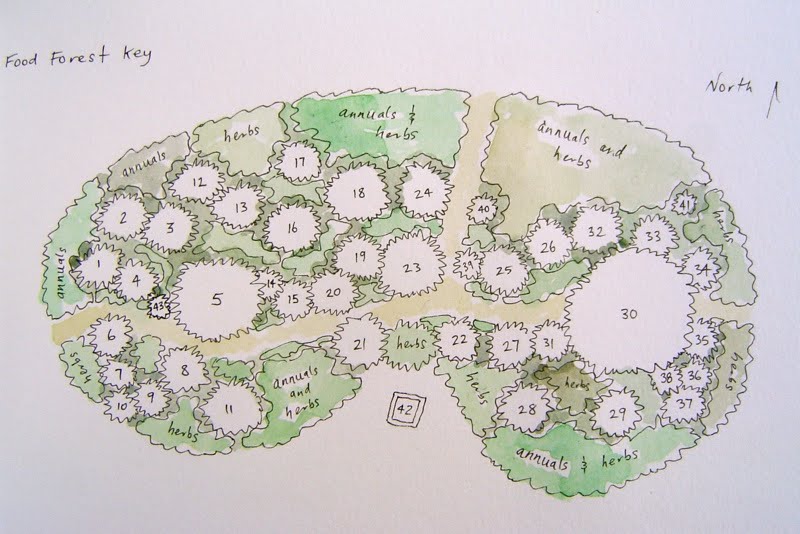
This cracked me up – I speculated that Jesus’ foot must have been encrusted with quite a lot of organic matter to create a garden this fertile. This led to a discussion of the Christian tradition of ‘the washing of the feet‘ as a possible method of getting more nutrient into the soil. But Francis lamented that these days, his parishoners attend church with feet which are already scrupulously clean, so the act is more socially symbolic than botanically useful.
Standing next to Francis is Costa, the gregarious gardening guru from SBS TV. It was great to have Costa hanging around, gesticulating wildly and keenly to anyone he bumped into about the wonders of growing-your-own. Costa told me about his love of chickens – apparently he takes “his girls” along with him when he does gardening jobs, as conscripted workers to clear up weeds in one part of the yard while he works on another.
I asked Costa if he’d be able to bring himself to kill his chickens, when they reach “a certain age”. He was doubtful, especially since they all already have names (“Henrietta” is the only name I remember).
Oh, and here’s the Family themselves, in their classic “American-Gothic-but-Cheerful” pose, being photographed by Anna the curator:
As I hinted above, members of The Family were quite laissez-faire in their approach to managing the Plant-In Day. Typically, the request for instructions from Meg or Patrick would be offered a rather open reply, along the lines of “Hmm, well, let’s see… Plant it where ever you think best”. We the punters were largely left to our own devices, scratching our heads and consulting amongst ourselves about what to do and where to help out. This may have been a little challenging at the time. In retrospect, I think it was an interesting strategy for forcing us to own our contributions – not just the action of planting something, but the decisions which we made via our own initiative.
For an artist group from out of town, this was perhaps a wise strategy. Once they leave (in fact, they’re already long gone) it’s up to us to tend this forest until it is strong enough to tend to itself.

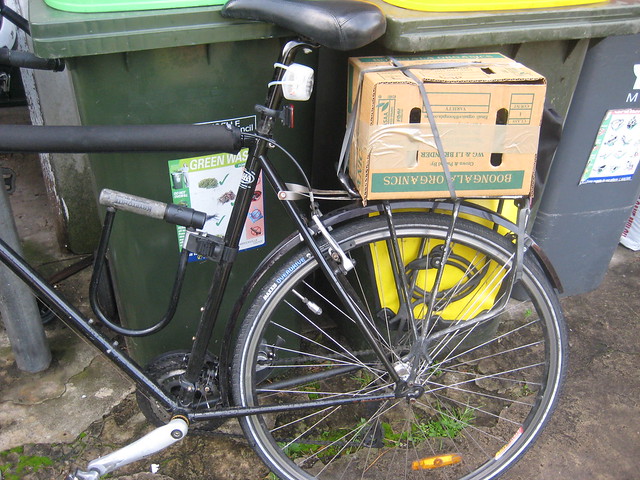





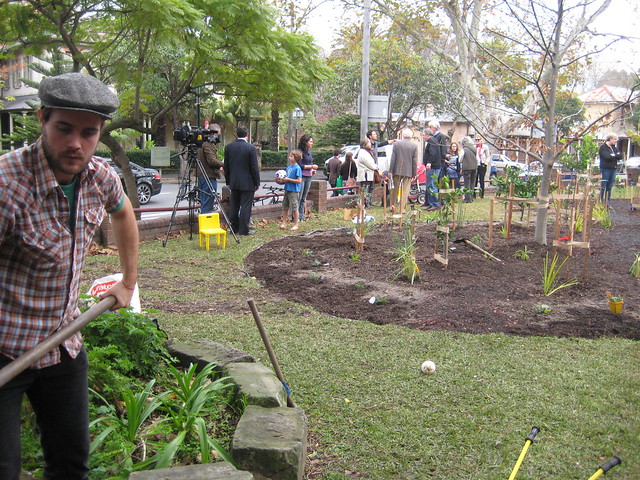
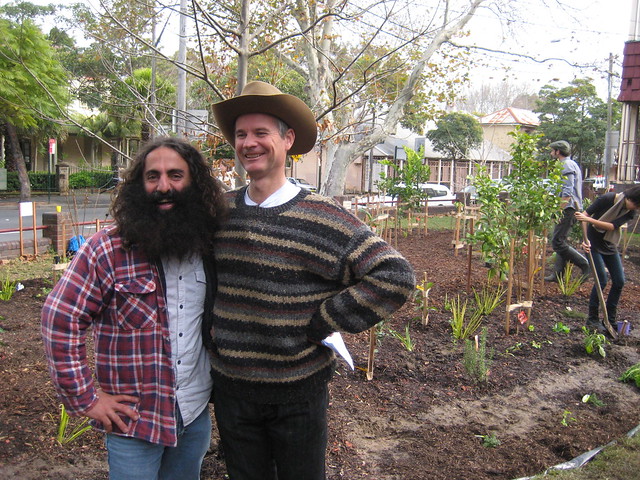
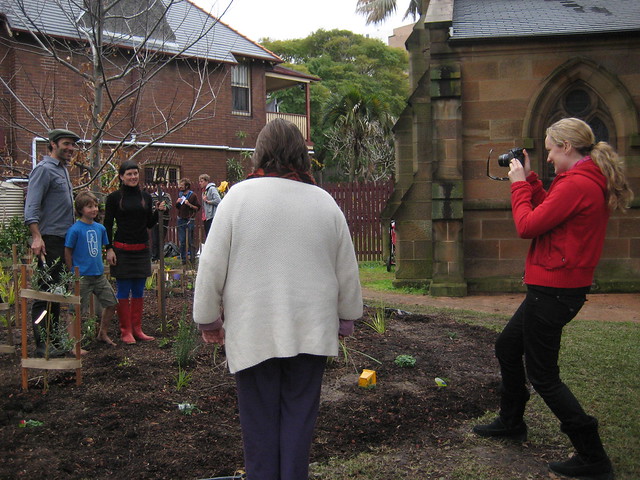
UPDATE! I just heard from Tessa from Makeshift, who writes:
hello lucas, thanks for your take on food forest and the great pics. it really was a great day and thanks for your persistent hard work throughout the plant-in. just a few things in response:
food forest has been designed to create habitat and food for non-humans and food for humans and depends on these webs of interrelation for it to work. as the forest grows these webs will become more dynamic and pronounced. as soon as we started planting trees, locals birds visited them (as our film attests: http://theartistasfamily.blogspot.com/2010/07/ten-days.html).
microfungi will develop under the wood mulch, spiders, frogs and lizards will make their way there, all of the exotics and local bush foods we planted will attract insects, bees and birds. Habitat has also been created to encourage microflora and microfauna – our forest is an example of applied ecology that is transitioning away from anthropocentric food supply systems such as supermarket, fast food outlets and even more traditional ‘raised bed’ type gardens that don’t provide habitat. We are still to add some rocks and logs to the forest floor.
urban farming is becoming a big deal, but this form of food supply, albeit a thousand times better than transported food, strikes me as still quite anthropocentric, which is why we are offering ‘urban food forestry’ as an alternative or partner. food can be grown vertically to deal with the limitations of space in urban environments while providing habitat.
bill mollison wrote (back in the day) that a mature oak tree provides as much food as an acre of wheat. we can believe it because we have only a 20 year old oak tree in our back yard from which the local rosellas, wattlebirds, crows, corellas, finches and us harvest massive amounts of food, yearly humus and shade, and we all benefit from the carbon sequestering.
(check out my acorn cake recipe: http://permapoesis.blogspot.com/2010/06/greenwash-12-in-trouble-eating-7000.html and more on urban food forestry here: http://permapoesis.blogspot.com/2010/01/greenwash-14-in-trouble-urban-food.html)
Thanks AAF for your lovely summary. I’m looking forward to seeing the garden after a month of growth. My fennel seedlings at home (which I planted at the same time as the AAF plant-in day) are just beginning to look like little teenage versions of their future bulbous selves.
also! – Pete (who is posing in the above photos in the purple shirt) just wandered past where I’m sitting in the MCA offices. I told him what I wrote above – that I’d never before really thought to tap into his knowledge of farming. (Pete’s main farm experience is at his mum’s place, a few hours from Sydney.)
He leaned in close, admiring the picture of himself (and pleased, I think, to be making a cameo appearance in the blog) and said: “You know it’s funny, all these artists doing projects about farming, and Diego’s project about weeds. It’s alright to consider weeds interesting in the city, but out in the country it’s serious business. A while ago when there was a big rain, it came up all green, and you’d think we’d be happy. But it wasn’t grass at all. It was heliotrope. The animals can’t eat it, there isn’t anything for them to eat. You can hit it with weedkiller, but apparently it’s the last thing that dies after you’ve killed off everything else…”
At this he was called away to another job.
ha ha ha, of course.
PWS knows better than that too lucas, he knows himself it gonna get worse, unless you change way to live off the land, so he plants trees, lots of Kurrajong i believe, to help stabilize the water levels and keep water resources on the property.
🙂
hi lucas, just picking up on pete’s rather naive posit above:
i’ve lived in the country most of my life. my family and i incorporate weeds into our diet every day.
there are about 30 common weeds in our area in central victoria, about twenty of these are a free, nutritious mainstay of our diet. we are therefore not reliant on monological agriculture and we supplement our garden produce with our foraged produce for a fully post-capitalist, post-pollution diet.
pete’s view is old-school country, but some of us out here are thinking better ways. traditional farming practices have only created environmental disaster, especially the depletion of topsoil, which was at 3% pre-invasion. it is now down to 1% courtesy of idiotic farming practices. many weeds fix nitrogen and are attempting to repair the land as it is perpetually disturbed.
for more on edible weeds go: http://www.gardennotesforrelocalisation.blogspot.com
indeed! thanks patrick.
as well as being “old-school country”, pete is old-school technology – so I’ll have to pass your reply onto him personally.
I’ll let you know what his response is when I (physically) track him down…
I think the issue here is far more complex than simply discerning between ‘old school’ and ‘new trend’ agricultural practices.
The logic behind monocultural practices of most farmers have to be found in politics of economy, which under the current main stream understanding revolves around vast area being cultivated as a single crop.
I too grew up in the country, co-managed a dairy farm on the other side of the world and worked in orchards and garden centres on this side of the world, and one thing i learned is the inability of primary producers to free themselves from the economical imperatives of the industry. As long as the current distribution system is based on iperproduction>iperconsumerism>discard of surplus, we as a human race will just keep eating away the resources, plundering the land for a single produce instead of diversifying and take advantage of the abundance.
As Vandana Shiva says, we are at war with the dirt, since the industrialisation of the primary sector.
The politics of agriculture and food production have far reaching geopolitical implications.
All farmers would love to have a green pasture, with lots of different animals and species growing on it, in a harmonious bioregion, but this practice is not economically viable for many, until they free themselves from the shackles of multinationals.
Unfortunately we don’t have time, and this is why so many people are afoot.
To keep it on topic i’d like to post the link of some good friends, the Milkwooders, who will run a Regenerative Agriculture workshop this very weekend, free for farmers, see here.
As for the weeds then, many more topics should be covered in trying to understand the intricate relationship we human have with the botany that surround us, they are our best botanical friends by far, if nothing else because they can withstand us..